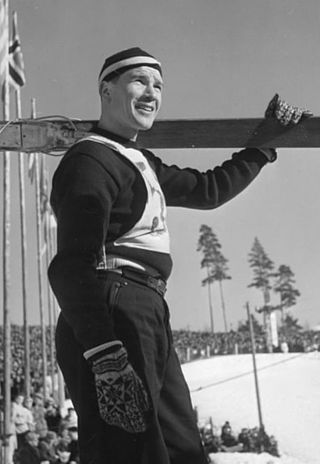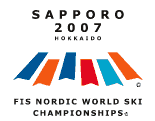Related Research Articles

Nordic combined is a winter sport in which athletes compete in cross-country skiing and ski jumping. The Nordic combined at the Winter Olympics has been held since the first Winter Olympics in 1924, while the FIS Nordic Combined World Cup has been held since 1983. Many Nordic combined competitions use the Gundersen method, where placement in the ski jumping segment results in time (dis)advantages added to the contestant's total in the cross-country skiing segment.

The 1948 Winter Olympics, officially known as the V Olympic Winter Games and commonly known as St. Moritz 1948, were a winter multi-sport event held from 30 January to 8 February 1948 in St. Moritz, Switzerland. The Games were the first to be celebrated after World War II; it had been twelve years since the last Winter Games in 1936.
At the 1924 Winter Olympics, four Nordic skiing events were contested – two cross-country skiing events, one ski jumping event, and one Nordic combined event, all for men only.
At the 1928 Winter Olympics, four Nordic skiing events were contested – two cross-country skiing events, one ski jumping event, and one Nordic combined event, all for men only.
At the 1936 Winter Olympics, five Nordic skiing events were contested – three cross-country skiing events, one ski jumping event, and one Nordic combined event, all for men only.

The FIS Nordic World Ski Championships is a biennial Nordic skiing event organized by the International Ski Federation (FIS). The World Championships was started in 1925 for men and opened for women's participation in 1954. World Championship events include Nordic skiing's three disciplines: cross-country skiing, ski jumping, and Nordic combined. From 1924 to 1939, the World Championships were held every year, including the Winter Olympics. After World War II, the World Championships were held every four years from 1950 to 1982. Since 1985, the World Championships have been held in odd-numbered years.

Simon Kaurin Slåttvik was a Norwegian skier. He competed at the 1952 Winter Olympics in the Nordic combined and 18 km cross-country skiing and won the gold medal in the former event. Earlier he won a Nordic combined bronze medal at the 1950 World Championships. He won 14 Norwegian titles and was the first Nordic combined athlete to jump over 100 m. Slåttvik won the Nordic combined event at the Holmenkollen ski festival in 1948, 1950 and 1951, and was awarded the Holmenkollen medal in 1951.
At the 1968 Winter Olympics, ten Nordic skiing events were contested – seven cross-country skiing events, two ski jumping events, and one Nordic combined event.
At the 1992 Winter Olympics, fifteen Nordic skiing events were contested – ten cross-country skiing events, three ski jumping events, and two Nordic combined events.

Nils Emanuel Karlsson, better known as Mora-Nisse, was a Swedish cross-country skier. Karlsson won gold in the 50 km event at the 1948 Winter Olympics and nine Vasaloppet victories.
At the 1952 Winter Olympics in Oslo, six Nordic skiing events were contested – four cross-country skiing events, one ski jumping event, and one Nordic combined event. It was also the first time that women were allowed to compete in cross-country skiing at the Olympics.

The Nordic combined events have been contested at the Winter Olympic Games since 1924. The first competition involved 18 km cross-country skiing, followed by ski jumping.

Oddbjørn Hagen was a Norwegian skier who competed in Nordic combined and cross-country skiing. He was both Olympic and World champion.

Heikki Vihtori Hasu is a Finnish retired Nordic skier who competed in the 1948 and 1952 Olympics.

Martin Lundström was a Swedish cross-country skier who competed in the late 1940s and early 1950s. He was born in Tvärliden, Norsjö Municipality.

The FIS Nordic World Ski Championships 2007 took place 22 February – 4 March 2007 in Sapporo, Japan. It was the second time this city has hosted these championships, having previously done so in the 1972 Winter Olympics. Sapporo was selected as venue by vote at the 43rd FIS World Congress in Portorož, Slovenia, on 6 June 2002. It also marked the third time the championships were hosted outside Europe in a year that did not coincide with the Winter Olympics; it was the first championship held in Asia. The ski jumping team normal hill event was not held, as it had been in 2005.

The FIS Nordic World Ski Championships 2009 took place 18 February – 1 March 2009 in Liberec, Czech Republic. This was the fourth time these championships were hosted either in the Czech Republic or in Czechoslovakia, having done so at Janské Lázně (1925) and Vysoké Tatry.

The FIS Nordic World Ski Championships 2011 took place from 23 February to 6 March 2011 in Oslo, Norway, at the Holmenkollen National Arena. It was the fifth time these championships had been hosted in Holmenkollen, having been done previously in 1930, the 1952 Winter Olympics, 1966, and 1982. On 25 May 2006, the 45th FIS Congress in Vilamoura, Portugal, selected the Holmenkollen area over both Val di Fiemme, Italy, and Zakopane, Poland, with a vote of 12 to 4 to 0. These games coincided with the Holmenkollen Ski Festival as they have previously in 1930, 1952, 1966, and 1982.
Karl-Erik Åström was a Swedish cross-country skier who competed in the 1950s. He won two gold medals at the 1950 FIS Nordic World Ski Championships in the 18 km and the 4 x 10 km.

The Whistler Olympic Park is the location of the Nordic events facilities for the 2010 Winter Olympics and is located in the Madeley Creek basin in the Callaghan Valley, west of Whistler, British Columbia, Canada. The facility hosted the biathlon, cross-country skiing, Nordic combined, and ski jumping. After the Olympics the park remains a public facility, complementing the extensive wilderness trails and alpine routes already in use. Three temporary stadiums were built with a capacity for 12,000 spectators each. The location is approximately 8 km from the junction of its access road with Highway 99 and 14 km from the Whistler Olympic Village.
References
- ↑ "Martin LUNDSTRÖM". olympics.com. Retrieved 28 May 2024.
- ↑ "Cross Country Skiing - Medalists". olympics.com. Retrieved 28 May 2024.
- ↑ "Petter HUGSTED". olympics.com. Retrieved 28 May 2024.
- ↑ "Heikki HASU". olympics.com. Retrieved 28 May 2024.